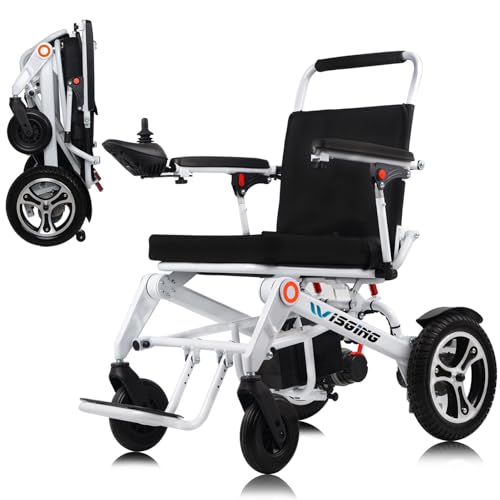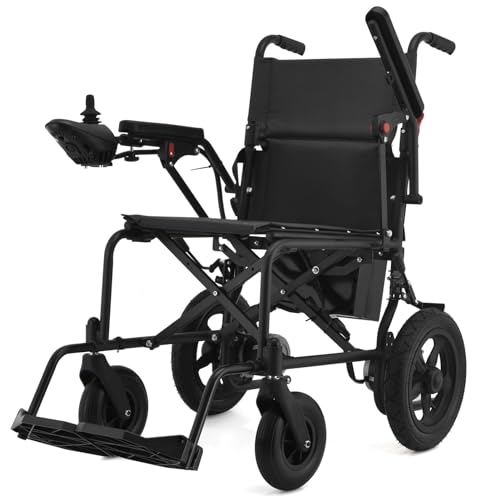17 Reasons Why You Shouldn't Ignore Electric Wheelchair With Joystick
페이지 정보
작성자 Odessa Pittman 작성일24-09-08 21:38 조회57회 댓글0건본문
 small lightest electric wheelchair wheelchair for indoors uk; Recommended Internet site, Wheelchair With Joystick
small lightest electric wheelchair wheelchair for indoors uk; Recommended Internet site, Wheelchair With JoystickJoysticks on power wheelchairs can significantly increase the user's independence and make it easier to use. However, standardized joysticks can be incompatible with the individualized features of hand disorders.
This study examined the efficacy and satisfaction of customized power wheelchair joysticks fabricated with 3D printing technology. Modified power-mobility indoor driving assessment (PIDA), National Aeronautics and Space Administration task load index, and psychosocial impact of assistive devices scale were employed to evaluate.
Control
The control system of a power wheelchair comprises two essential components which are the joystick as well as the electronics (also called the controller). The standard joysticks are placed on either the left or right side of the wheelchair, whereas more complicated rehab chairs have swing-away mounts which allow the joystick to move into the middle of the seat.
The way in which a joystick is mounted and used is essential to its performance for a client. If a user has a high number of tremors, it is essential to design the joystick so that the movements don't trigger the chair inadvertently. Standard EPW joysticks generally use proportional input devices, which respond to the level of deflection on the gimbal to determine the direction of the chair (similar to an accelerator pedal or video game controller).
However, there are now numerous alternative control options for power wheelchairs that require minimal force to activate. These include switch controls sip and puff control, head array systems and chin control. While some of these specialty controls require a separate interface to connect them to the wheelchair, many are compatible with the new generation of joysticks, which have integrated Bluetooth into their handles.
Some wheelchair joysticks come with a screen to display the current status of the system and provide feedback to the user, which can be particularly useful for people with cognitive or visual impairments. Other advanced joysticks have the capability of controlling a variety of accessories like environmental controls, and even a tablet or TV.
No matter what technology is used, a joystick is only as useful as it is comfortable for the user operate. It is therefore essential to think about the dimensions of the buttons and their placement on the joystick to make them easily accessible. Additionally, it is important to consider the sensitiveness of the joystick which can be adjusted to a range of levels according to the requirements of each user.
Comfort
A joystick-controlled power chair has many advantages not available with a manual chair. They help reduce fatigue due to operational factors and can travel for longer distances than manual chairs. They can also be used in locations with fewer spaces and more challenging terrain than a manual one, like uneven surfaces or slopes in the outdoors. This added independence allows users to experience the freedom of movement and feeling of independence.
A variety of power wheelchairs are offered with many options. The number of bells and whistles a particular model features will depend on what the user wants and requires. Some of the most common features are:
Controls on an electric powered wheelchairs wheelchair with joystick can be customized to meet your individual requirements. This includes the design and location of the knob, ball, or handle. Some joysticks are mounted on the top of the dominant armrest while others are located in the front or back of the seat for easy access by the attendant. Certain joysticks can be placed on the side for people with limited shoulder range or a weakness in their muscles.
Other features can be more customized, such as the style and size of the joystick's display. Some are backlit or in colors that are easier to read for those who have low vision. Some models also have auxiliary modes that offer visual or audio cues to aid in navigation. Other models can include odometers, clocks, and indicators for battery charge.
Another important aspect of the joystick is how it can be operated within a tight turning radius. The best models will have a tight turning radius that makes it easier to maneuver obstacles in narrow spaces, like hallways. The narrow radius allows for easier maneuvering in public areas and stores. This tight turning circle is particularly useful for people who have mobility issues, like cerebral palsy or other issues with mobility such as multiple sclerosis ALS and Huntington's Disease. brainstem injury or spinal cord stroke.
Safety
Power wheelchairs are designed with safety in mind. They have robust brake systems that can limit the speed rapidly when the user presses the joystick control. The chairs also come with anti-tip rear wheels that prevent the chair from tipping forward.
The most popular type of joystick is a proportional control. It is similar to video game controllers as well as automobile accelerator pedals in that it makes the wheelchair move faster the further it is away from the center. These joysticks require finger dexterity and intact proprioception to operate. A standard joystick is placed on the armrest, however, a variety of specific controls are available that mount the controls in the middle or at the sides of the seat.
Even with special rigging, some people might not be able deflect a handle. Certain people who suffer from spasticity could be a bit troubled due to their muscles becoming stiff or atrophy. In these cases, it may be better to utilize a head-control unit that converts the movements of the consumer's body into the required commands for the wheelchair.
The size and position of the buttons on the joystick is another thing to consider. If the buttons are too far in the front or difficult to reach, they could hinder the seating position of the user and cause stress on the hands. On the other side when the joystick is placed too far backwards it could be difficult to turn the wheels or move the chair through tight spaces.
The seatbelt should be secured on an electric wheelchairs for sale transportable electric wheelchair. Seatbelts should always be fastened when using an lightest electric wheelchair uk wheelchair. The most powerful wheelchairs can reach speeds of 8mph. It is also important to keep batteries charged regularly, at least every night if possible. This will help them to last longer and help maintain their effectiveness. You should also have your chair checked regularly to ensure that all components are operating properly.
Accessories
The joystick is a key component of any power wheelchair and there are numerous accessories that can be added to improve its performance. These range from simple switches to more sophisticated interfaces that can be connected to communication devices or even external environmental control units. A high-end power wheelchair will often have a variety of controller components that can be used and adapted to meet the requirements of a particular user. A non-expandable controller will only accept the proportional stick as an input device while an expandable model can also take sip and puff controls, special switches, as well as head array systems. Some of the more advanced controllers can also operate up to 2 power seating actuators that are able to adjust the position and tilt of the seat.
The most popular type of joystick used in clinics is a proportional joystick also known as a movement-sensing joystick. This type of joystick like accelerator pedals for cars and video game controllers responds to the force applied on the stick by increasing its output (i.e. wheelchair speed) as the stick is pushed away from the center. This requires a good amount of intact proprioception and dexterity for efficient use.
The technology used today can compensate for minor amplitude movement during EPW driving. However, it is unable to detect and adjust for more serious unintentional movements, like those that cause larger amplitude tremors, or involuntary movements that are not associated with conscious intention like athetosis.
Most wheelchairs can be customised and programmed with the assistance of a clinician. These parameters can be used to alter the torque generated by the motor and adjusting the speed of the chair. They can also be used to determine the dead zone, which is the area at which the EPW isn't able to produce output. Some controllers allow the clinician to store backup programs. This is useful in an emergency situation or when the symptoms of a patient alter.

댓글목록
등록된 댓글이 없습니다.

